The Plastic Healthcare Packaging Industry Analysis in Japan is estimated to be valued at USD 0.8 billion in 2025 and is projected to reach USD 1.2 billion by 2035, registering a compound annual growth rate (CAGR) of 4.1% over the forecast period.
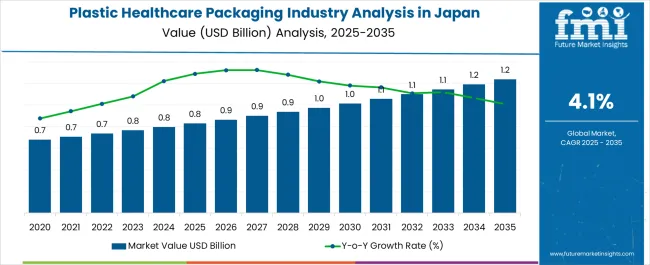
| Metric | Value |
|---|---|
| Plastic Healthcare Packaging Industry Analysis in Japan Estimated Value in (2025 E) | USD 0.8 billion |
| Plastic Healthcare Packaging Industry Analysis in Japan Forecast Value in (2035 F) | USD 1.2 billion |
| Forecast CAGR (2025 to 2035) | 4.1% |
The plastic healthcare packaging market in Japan is witnessing steady growth. Increasing demand for safe, durable, and lightweight packaging solutions in the healthcare sector is driving adoption. Current market dynamics are characterized by rising pharmaceutical production, stringent regulatory standards, and heightened focus on patient safety and product integrity.
Technological advancements in polymer processing and barrier properties have enhanced packaging performance. The future outlook is shaped by growing investments in healthcare infrastructure, expanding biologics and vaccine production, and the rising preference for eco-friendly and recyclable materials.
Growth rationale is underpinned by the need for efficient and contamination-free packaging solutions, the ability of manufacturers to deliver high-quality, compliance-ready products, and the strategic adoption of innovative materials and designs that ensure product stability and operational efficiency Collectively, these factors are expected to sustain market expansion and reinforce Japan’s position as a key market for plastic healthcare packaging solutions.
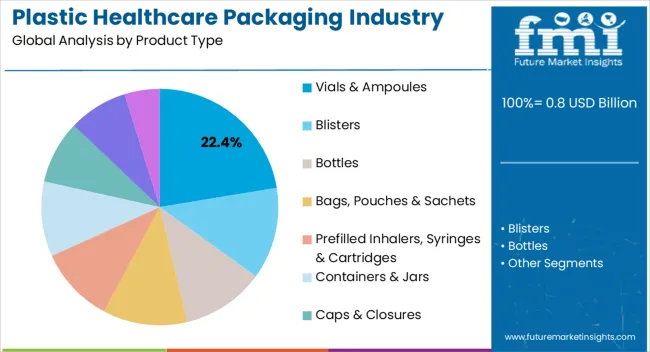
The vials & ampoules segment, representing 22.40% of the product type category, has maintained market leadership due to its critical role in drug storage, delivery, and dosage accuracy. Adoption has been supported by robust design standards, high material integrity, and compliance with pharmaceutical regulations.
The segment’s prominence is reinforced by consistent demand from hospitals, clinics, and pharmaceutical manufacturers, while process improvements in molding and sterilization techniques have enhanced product quality. Reliability and safety in handling sensitive drugs have strengthened preference among healthcare providers.
Strategic collaborations between packaging suppliers and pharmaceutical companies have further supported market penetration Continuous innovation in design and material optimization is expected to sustain the segment’s share and maintain its competitive position within the Japanese healthcare packaging landscape.
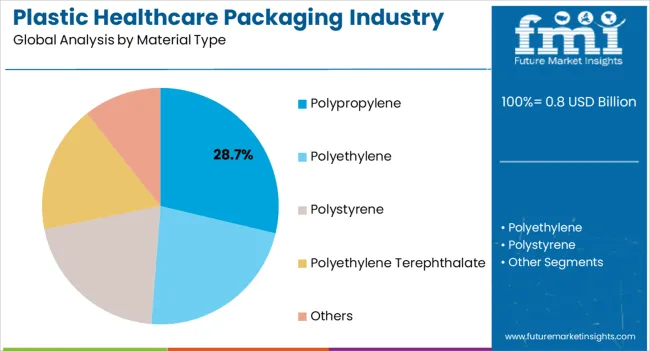
The polypropylene segment, accounting for 28.70% of the material type category, has emerged as the leading material due to its chemical resistance, durability, and cost-effectiveness. Widespread adoption has been driven by suitability for sterilization, compatibility with a wide range of pharmaceutical products, and regulatory compliance.
Manufacturers have leveraged processing improvements to enhance barrier properties, dimensional stability, and clarity. Polypropylene’s recyclability and environmental advantages have further reinforced its preference over alternative polymers.
Consistent supply and standardization in quality have strengthened adoption across healthcare packaging applications Continued material innovation, combined with evolving regulatory requirements, is expected to maintain the segment’s market share and support growth in specialized and high-volume packaging applications.
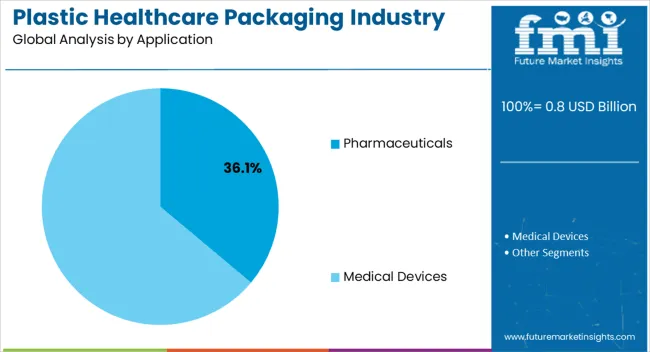
The pharmaceuticals application segment, holding 36.10% of the application category, has remained dominant due to increasing production and distribution of drugs, vaccines, and biologics in Japan. Adoption has been driven by regulatory compliance requirements, stringent quality control standards, and the need for contamination-free packaging solutions.
The segment benefits from reliable supply chains, compatibility with various drug formulations, and high operational efficiency in hospitals and pharmacies. Demand has been reinforced by expanding pharmaceutical manufacturing and rising consumption of packaged drugs.
Innovation in packaging design, including tamper-evident and child-resistant features, is further supporting adoption These factors are expected to sustain the segment’s leadership and drive continued growth in the Japanese healthcare packaging market.
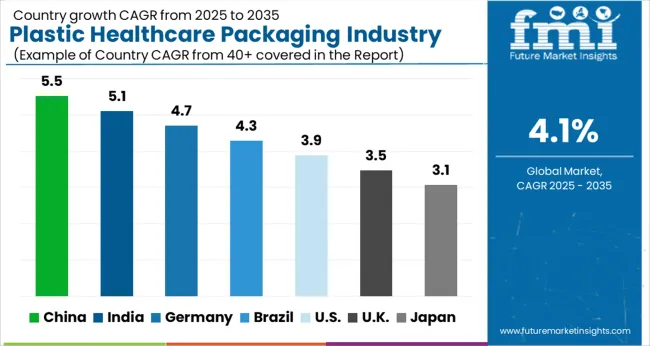
Technological advancements in various industries, including healthcare packaging. Research and development centers in the region contribute to developing cutting-edge materials, designs, and technologies for packaging.
Kanto, being a highly populated and urbanized area, often experiences more acute environmental concerns. This may lead to a stronger push for sustainable packaging solutions and greater consumer awareness and demand for eco-friendly options.
The high presence of the pharmaceutical industry contributes to producing high-quality plastic healthcare packaging materials and solutions in Chubu. The growing technological advancement and emphasis on innovation in the healthcare sector drive the industry demand.
Increased research and development facilities within Chubu drive advancements in packaging materials, designs, and production techniques for pharmaceuticals and medical devices are the key factors supporting demand.
Based on the material, plastic healthcare packaging in Japan will likely be dominated by the polypropylene segment, with a share of 34.50%.
Polypropylene is a versatile material that can be molded into various forms, making it suitable for different types of healthcare packaging, including bottles, containers, closures, and blister packs. Polypropylene has excellent chemical resistance, ensuring that it maintains the integrity of pharmaceuticals and medical devices by protecting them from potential contamination or interaction with the packaging material.
Polypropylene can be made transparent, allowing for easy visibility of the packaged product. This is advantageous for pharmaceuticals where visual inspection is necessary. Polypropylene is recyclable, aligning with the growing focus on sustainability. With increased emphasis on eco-friendly packaging, the recyclability of PP makes it an attractive choice for healthcare packaging.
| Attribute | Details |
|---|---|
| Material | Polypropylene |
| Value Share | 34.50% |
Based on application, plastic healthcare packaging in Japan is likely to be dominated by the fixed segment, with a share of 58.40%.
Different medical devices require tailored packaging solutions to ensure proper protection and ease of use. Plastic packaging allows for customizable designs that cater to the specific requirements of various medical devices, from surgical instruments to diagnostic tools.
As new medical devices are developed, there is a parallel need for packaging solutions that ensure the safety, sterility, and functionality of these devices. Plastic packaging materials, including specialized films and containers, play a crucial role in ensuring the sterility of these devices throughout transportation and until their use.
| Attribute | Details |
|---|---|
| Application | Medical Devices |
| Value Share | 58.40% |
Companies operating in Japan's plastic healthcare packaging industry are aiming for strategic collaborations and partnerships with other manufacturers to expand their product portfolio and invest in capacity expansions. Industry players are also investing in expanding their production capacities. These initiatives are aimed at enhancing their product portfolios and increasing their capability to meet the evolving demands of the healthcare sector.
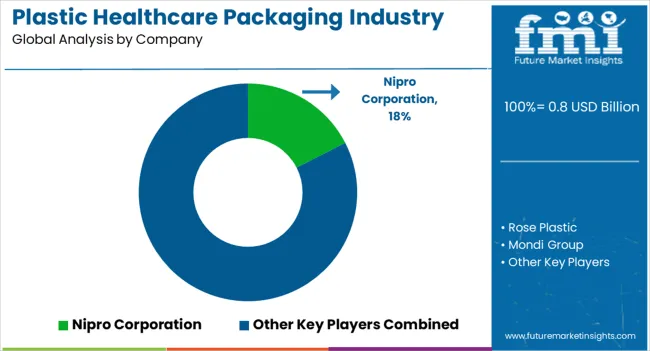
Product Offering
| Attribute | Details |
|---|---|
| Estimated Industry Size in 2025 | USD 0.8 billion |
| Projected Industry Size in 2035 | USD 1.2 billion |
| Anticipated CAGR between 2025 to 2035 | 4.1% CAGR |
| Historical Analysis of Plastic Healthcare Packaging in Japan | 2020 to 2025 |
| Forecast for Deployment of Plastic Healthcare Packaging in Japan | 2025 to 2035 |
| Report Coverage | Industry Size, Industry Trends, Analysis of key factors influencing Deployment of Plastic Healthcare Packaging in Japan, Insights on Global Players and their Industry Strategy in Japan, Ecosystem Analysis of Local Providers in Japan. |
| Key Region Analyzed While Studying Opportunities in the Plastic Healthcare Packaging in Japan | Kanto Region; Chubu Region; Kinki (Kansai); Kyushu and Okinawa; Tohoku |
| Key Companies Profiled | Rose Plastic; Nipro Corporation; Mondi Group; Adelphi Healthcare Packaging; Wipak Ltd; Aptar Group; West Rock Company; West Pharmaceutical Services; McKesson Corporation; Novio Packaging |
The global plastic healthcare packaging industry analysis in Japan is estimated to be valued at USD 0.8 billion in 2025.
The market size for the plastic healthcare packaging industry analysis in Japan is projected to reach USD 1.2 billion by 2035.
The plastic healthcare packaging industry analysis in Japan is expected to grow at a 4.1% CAGR between 2025 and 2035.
The key product types in plastic healthcare packaging industry analysis in Japan are vials & ampoules, blisters, bottles, _dropper bottles, _nasal spray bottles, _liquid bottles, bags, pouches & sachets, _iv bags, _medical specialty bags, prefilled inhalers, syringes & cartridges, containers & jars, caps & closures, trays and medication tubes.
In terms of material type, polypropylene segment to command 28.7% share in the plastic healthcare packaging industry analysis in Japan in 2025.






Our Research Products

The "Full Research Suite" delivers actionable market intel, deep dives on markets or technologies, so clients act faster, cut risk, and unlock growth.

The Leaderboard benchmarks and ranks top vendors, classifying them as Established Leaders, Leading Challengers, or Disruptors & Challengers.

Locates where complements amplify value and substitutes erode it, forecasting net impact by horizon

We deliver granular, decision-grade intel: market sizing, 5-year forecasts, pricing, adoption, usage, revenue, and operational KPIs—plus competitor tracking, regulation, and value chains—across 60 countries broadly.

Spot the shifts before they hit your P&L. We track inflection points, adoption curves, pricing moves, and ecosystem plays to show where demand is heading, why it is changing, and what to do next across high-growth markets and disruptive tech

Real-time reads of user behavior. We track shifting priorities, perceptions of today’s and next-gen services, and provider experience, then pace how fast tech moves from trial to adoption, blending buyer, consumer, and channel inputs with social signals (#WhySwitch, #UX).

Partner with our analyst team to build a custom report designed around your business priorities. From analysing market trends to assessing competitors or crafting bespoke datasets, we tailor insights to your needs.
Supplier Intelligence
Discovery & Profiling
Capacity & Footprint
Performance & Risk
Compliance & Governance
Commercial Readiness
Who Supplies Whom
Scorecards & Shortlists
Playbooks & Docs
Category Intelligence
Definition & Scope
Demand & Use Cases
Cost Drivers
Market Structure
Supply Chain Map
Trade & Policy
Operating Norms
Deliverables
Buyer Intelligence
Account Basics
Spend & Scope
Procurement Model
Vendor Requirements
Terms & Policies
Entry Strategy
Pain Points & Triggers
Outputs
Pricing Analysis
Benchmarks
Trends
Should-Cost
Indexation
Landed Cost
Commercial Terms
Deliverables
Brand Analysis
Positioning & Value Prop
Share & Presence
Customer Evidence
Go-to-Market
Digital & Reputation
Compliance & Trust
KPIs & Gaps
Outputs
Full Research Suite comprises of:
Market outlook & trends analysis
Interviews & case studies
Strategic recommendations
Vendor profiles & capabilities analysis
5-year forecasts
8 regions and 60+ country-level data splits
Market segment data splits
12 months of continuous data updates
DELIVERED AS:
PDF EXCEL ONLINE
Plastic Healthcare Packaging Industry Analysis in Western Europe Size and Share Forecast Outlook 2025 to 2035
Plastic Healthcare Packaging Industry Analysis in Korea Size and Share Forecast Outlook 2025 to 2035
Europe Healthcare Rigid Plastic Packaging Market Trends – 2024-2034
Plastic Healthcare Packaging Market Size and Share Forecast Outlook 2025 to 2035
Competitive Overview of Plastic Healthcare Packaging Providers
Japan Flexible Plastic Packaging Market Report – Demand, Trends & Industry Forecast 2025-2035
Flexible Plastic Packaging Industry Analysis in United States Size and Share Forecast Outlook 2025 to 2035
Bubble Wrap Packaging Industry Analysis in Japan Size and Share Forecast Outlook 2025 to 2035
Healthcare and Laboratory Label Industry Analysis in Japan Size and Share Forecast Outlook 2025 to 2035
Japan Molded Fiber Pulp Packaging Market Trends – Growth & Forecast 2023-2033
Plastic Packaging For Food and Beverage Market Size and Share Forecast Outlook 2025 to 2035
Plastic Packaging Market Size and Share Forecast Outlook 2025 to 2035
Japan Bio-Plasticizers Market Analysis – Size, Share & Forecast 2025-2035
Plastic Jar Packaging Market Forecast and Outlook 2025 to 2035
Plastic Jar Industry Analysis in the United States Size and Share Forecast Outlook 2025 to 2035
Competitive Overview of Plastic Jar Packaging Companies
Japan Stick Packaging Market Insights – Size, Demand & Trends 2025-2035
Plastic Drum Industry Analysis in Malaysia Size and Share Forecast Outlook 2025 to 2035
Plastic-free Packaging Market Size and Share Forecast Outlook 2025 to 2035
Plastic Tube Packaging Market Size and Share Forecast Outlook 2025 to 2035

Thank you!
You will receive an email from our Business Development Manager. Please be sure to check your SPAM/JUNK folder too.
Chat With
MaRIA